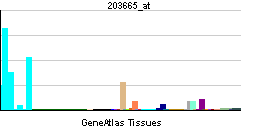HMOX1
| Heme oxygenase (decycling) 1 | |||||||||||||
|---|---|---|---|---|---|---|---|---|---|---|---|---|---|
 PDB rendering based on 1n3u. | |||||||||||||
| |||||||||||||
| Identifiers | |||||||||||||
| Symbols | HMOX1 ; HO-1; bK286B10 | ||||||||||||
| External IDs | Template:OMIM5 Template:MGI HomoloGene: 31075 | ||||||||||||
| |||||||||||||
| RNA expression pattern | |||||||||||||
 | |||||||||||||
| More reference expression data | |||||||||||||
| Orthologs | |||||||||||||
| Template:GNF Ortholog box | |||||||||||||
| Species | Human | Mouse | |||||||||||
| Entrez | n/a | n/a | |||||||||||
| Ensembl | n/a | n/a | |||||||||||
| UniProt | n/a | n/a | |||||||||||
| RefSeq (mRNA) | n/a | n/a | |||||||||||
| RefSeq (protein) | n/a | n/a | |||||||||||
| Location (UCSC) | n/a | n/a | |||||||||||
| PubMed search | n/a | n/a | |||||||||||
HMOX1 (heme oxygenase (decycling) 1) is a human gene that encodes for the enzyme heme oxygenase 1 (EC 1.14.99.3). Heme oxygenase is an essential enzyme in heme catabolism, it cleaves heme to form biliverdin.
Heme oxygenase, an essential enzyme in heme catabolism, cleaves heme to form biliverdin, which is subsequently converted to bilirubin by biliverdin reductase, and carbon monoxide, a putative neurotransmitter. Heme oxygenase activity is induced by its substrate heme and by various nonheme substances. Heme oxygenase occurs as 2 isozymes, an inducible heme oxygenase-1 and a constitutive heme oxygenase-2. HMOX1 and HMOX2 belong to the heme oxygenase family.[1]
The HMOX gene is located on the long (q) arm of chromosome 22 at position 13.1, from base pair 34,101,636 to base pair 34,114,748.
Related conditions
See also
References
Further reading
- Yachie A, Niida Y, Wada T, Igarashi N, Kaneda H, Toma T, Ohta K, Kasahara Y, Koizumi S (1999). "Oxidative stress causes enhanced endothelial cell injury in human heme oxygenase-1 deficiency". J Clin Invest. 103 (1): 129–35. PMID 9884342.
- Soares MP, Brouard S, Smith RN, Bach FH (2002). "Heme oxygenase-1, a protective gene that prevents the rejection of transplanted organs". Immunol. Rev. 184: 275–85. PMID 12086318.
- Morse D, Choi AM (2002). "Heme oxygenase-1: the "emerging molecule" has arrived". Am. J. Respir. Cell Mol. Biol. 27 (1): 8–16. PMID 12091240.
- Buelow R, Tullius SG, Volk HD (2002). "Protection of grafts by hemoxygenase-1 and its toxic product carbon monoxide". Am. J. Transplant. 1 (4): 313–5. PMID 12099373.
- Ishikawa K (2003). "Heme oxygenase-1 against vascular insufficiency: roles of atherosclerotic disorders". Curr. Pharm. Des. 9 (30): 2489–97. PMID 14529548.
- Exner M, Minar E, Wagner O, Schillinger M (2005). "The role of heme oxygenase-1 promoter polymorphisms in human disease". Free Radic. Biol. Med. 37 (8): 1097–104. doi:10.1016/j.freeradbiomed.2004.07.008. PMID 15451051.
- Ozono R (2006). "New biotechnological methods to reduce oxidative stress in the cardiovascular system: focusing on the Bach1/heme oxygenase-1 pathway". Current pharmaceutical biotechnology. 7 (2): 87–93. PMID 16724942.
- Tracz MJ, Alam J, Nath KA (2007). "Physiology and pathophysiology of heme: implications for kidney disease". J. Am. Soc. Nephrol. 18 (2): 414–20. doi:10.1681/ASN.2006080894. PMID 17229906.
- Hill-Kapturczak N, Agarwal A (2007). "Haem oxygenase-1--a culprit in vascular and renal damage?". Nephrol. Dial. Transplant. 22 (6): 1495–9. doi:10.1093/ndt/gfm093. PMID 17389623.
| Stub icon | This genetics article is a stub. You can help Wikipedia by expanding it. |